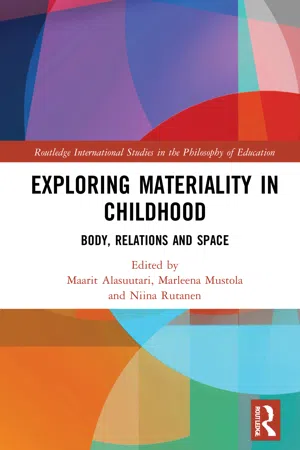
Exploring Materiality in Childhood
Body, Relations and Space
- 216 pages
- English
- ePUB (mobile friendly)
- Available on iOS & Android
Exploring Materiality in Childhood
Body, Relations and Space
About This Book
Exploring Materiality in Childhood: Body, Relations and Space explores the multiple ways that childhood and materiality are intertwined and assembled. Bringing together a diverse range of authors, this topical book makes a scholarly contribution to our understanding of the entanglements of materiality and childhoods in international contexts.
Chapters explore how various environments and material resources, including technologies and consumer goods, affect children's lives. The book caters to a diverse range of theories, in sociomaterialist, posthumanist, post-anthropocentric and more-than-human research, critically exploring the boundaries of these theoretical approaches with diverse empirical cases. These wide ranges of perspectives develop alternatives to human-centred approaches in understanding children and childhoods. With its diverse theoretical and methodological choices, the book also serves as a versatile example for how to conduct research with children and on childhood.
This book will be of great interest for academics, researchers, and postgraduate students in childhood studies, early childhood education, social sciences, cultural sciences and sociology.
Frequently asked questions
Information
Part I
Body, embodiment and
materiality
1 Becoming unruly?
Bodies and materials in a primary classroom
Paulina Semenec
Introduction (but first, an ‘unruly’ encounter)
Research context (and the persistence of children’s bodies in the classroom)
Minor story 1
(Unruly) cotton balls
Minor story 2
An (unruly) outfit
Table of contents
- Cover
- Half Title Page
- Series
- Title Page
- Copyright
- Contents
- List of figures
- List of contributors
- Introduction: Toward a material study of childhood
- Part I Body, embodiment and materiality
- Part II Materiality in/as relations
- Part III Space, environment and materiality
- Epilogue
- Index